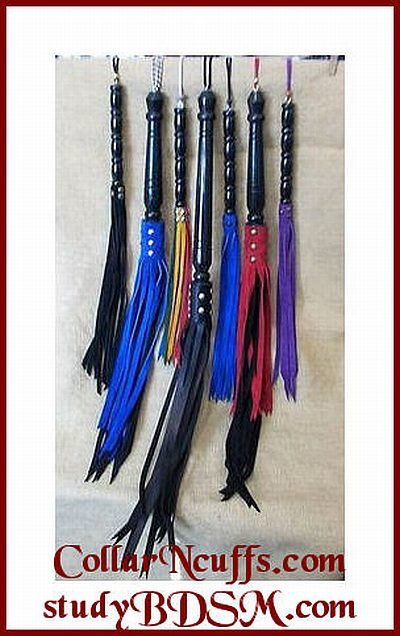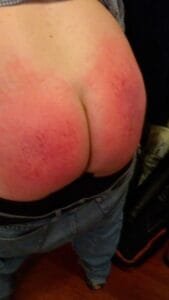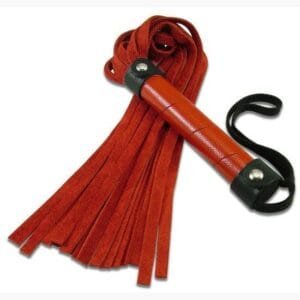What is the difference in the types of Floggers. Beyond weight, width, length, and point cut, the tail’s material matters most. There are a wide variety of leathers and other materials available, and each provides a different sensation.
I’ve ranked them here in roughly increasing order of severity. (Note: This is only a general guideline, based on what you’ll generally find under these names.

The fact is, the weight of leather and how it is tanned has a tremendous bearing on the “feel” of the leather. Whenever possible, touch for yourself rather than relying on descriptions… mine or anyone else’s.)
Table of Contents
types of floggers
- Chamois: The same thing you use to dry your car, chamois is buttery soft and very light. It’s rare to find a flogger made out of this stuff, and with good reason: chamois will provide almost no sensation at all! You’ll get some noise, a very light skin-level sensation, and not much else.
- Plonge: A thin, lightweight, buttery soft cow hide, plonge has a shiny finish and a lush suede side. It is extremely gentle, although it can produce significant sting if used with force. Very few whipmakers work in plonge.
- Deerskin: A light and velvety hide, deerkskin is great for caressing the body, and makes an excellent “warm-up” whip. Lots of noise, but very little impact. I find it makes loud thwack each time, yet most I use it on the recipients never flinch.
- Light Cowhide: Slightly stiffer and heavier than deerskin, light cowhide is used by some whipmakers as an “in between” material. It generally has a light thuddy feel.
- Elk: Heavier than deerskin, Elk is still fairly soft and compressible. It delivers almost pure thud, but gently so: you can put a lot of force behind a blow without risk of hurting someone.
- Full Suede: A bit harder and stiffer than Elk. Mostly thuddy, but can sting a bit if the tips are flicked quickly. I find most prefer a full suede and find it to be the most versatile
- Top-Grain Cowhide: These leathers are smooth on one side, creating less friction with the air and more sting on impact. Whipmakers seem to generally steer clear of these, perhaps because of the “mismatched” look of the tails.
- Moose: A dense and supple leather with a nice surface texture. Mostly thuddy, with some sting. Very few whipmakers work in moose.
- Buffalo or Bison: A thick, dense, yet soft leather with a very distinctive and defined grain. Very thuddy, but can sting if used correctly. Not many whipmakers work in this material.
- Bullhide: Heavier and less stretchy than buffalo, bullhide produces a lot of thud and some sting.
- Latigo: A very dense and tough cowhide, heavily tanned. Rarely used in floggers, latigo produces intense sting with very little effort.
Leather or Not…types of floggers
Leather isn’t the only material available when looking at types of floggers . Some very interesting floggers have been made from nontraditional materials. Rope: Unwind or unweave a rope, add a handle, and you have an interesting and versatile flogger. Widely frayed ends result in a very gentle toy; knotted ends can be more severe. Only a few whipmakers work with rope. ( found I have to make my own to get a decently balanced piece)
- Horsehair: Like a hair shirt, a horsehair flogger delivers the sensation of being scratched. This is one of the few floggers that grows less powerful as you make the fall thicker; more hair slows down the swing and reduces the impact. Horsehair flogger have some thud and very little sting, and doesn’t feel “scratchy” unless you strike with the very tips. Another, lighter horsehair flogger I tried had a lot of sting and felt quite scratchy.
- Rubber: Most people will caution you that rubber whips are very severe. I call these types “stingers“ that usually
Chain: Fine metal chain, or the ball chain used to turn on ceiling fans, is sometimes used to make floggers. Very intense, these should be used with great caution. Since they’re made of metal and hold temperature well, they’re more popular for dragging over the skin after being stored in a freezer than for actual floggings. thuddy feel. Chain floggers are fairly rare.
Floggers Versus Cats
Depending on who you ask, all floggers are cats, all cats are floggers, or they’re two distinctly different beasts. I tend to think of floggers as having flat tails and cats as anything with braided or round tails. In particular, nine braided tails with knotted or weighted ends is most definitely a cat.Cats tend to be quite severe, and go past sting into more of a “cutting” sensation.
Resource Article : MissBitch & MissBonnie © collarncuffs.com
Related Articles:
Floggers – How to use a flogger and get it right.
Different strokes – Different strokes, for different folks
Whip Breaking – Whip care & breaking in a new whip.
Spanking – Spanking know how.
Whipping guide – A general guide to whip play.
Bull whip safety – A general guide.
Melanoma & SM play – know the dangers.
Canes – How to use a cane the right way
Florentine flogging – Florentine flogging is a two-handed style of flagellation.
Synchronized flogging – (Video tutorial) instruction to Synchronized flogging







